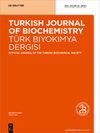The relationship of antioxidants with aging
IF 0.7
4区 生物学
Q4 BIOCHEMISTRY & MOLECULAR BIOLOGY
Turkish Journal of Biochemistry-turk Biyokimya Dergisi
Pub Date : 2013-01-01
DOI:10.5505/TJB.2013.21939
引用次数: 0
Abstract
Objective: In this study, it was aimed to investigate the changing levels of antioxidants along with aging. Malondialdehyde (MDA), total antioxidant (TAS) levels, and paraoxanase (PON) and arylesterase enzyme activities were examined as well as Coenzyme Q10, that has an immense role in production of ATP and, in fact, is a potent antioxidant with a lipophillic structure Methods: Research included 160 men and women whose ages differ from 20 to 70 years old and also live in Gaziantep area. Research was done by dividing subjects into 3 age groups: 50 people belonged to 20–30, 75 people to 31–50 and 35 people to 51–70 age group. Groups were constituted from people who are non-obese and who do not have any physical complaints. In taken plasma samples coenzyme Q10, MDA and TAS levels, PON and arylesterase enzyme activities were measured. The measurements were performed as follows: MDA by using thiobarbituric acid method, TAS, PON and arylesterase with spectrophotometric methods, and coenzyme Q10 with HPLC method were measured. Results: A correlation was found between age and coenzyme Q10 in our study (p<0.001). Coenzyme Q10 was found to be increased with aging. Statistically significant and negative linear relationship was found between coenzyme Q10, MDA levels, and PON and arylesterase activities (p<0.01, p<0.001). Conclusion: Despite the aging, the antioxidant system in healthy people works to protect the body from the endogenous or exogenous oxidants. However, levels of antioxidants cannot compansate with the rising oxidant levels in case of an illness. Aging is not a disease itself, but the process of aging is accelerated by a disease.抗氧化剂与衰老的关系
目的:探讨抗氧化剂水平随年龄增长的变化。研究人员检测了丙二醛(MDA)、总抗氧化剂(TAS)水平、对氧化酶(PON)和芳基酯酶活性以及辅酶Q10。辅酶Q10在ATP的产生中起着巨大的作用,事实上,辅酶Q10是一种具有亲脂结构的有效抗氧化剂。研究将受试者分为3个年龄组:20-30岁的50人,31-50岁的75人,51-70岁的35人。研究小组由不肥胖、没有任何身体不适的人组成。测定血浆中辅酶Q10、MDA和TAS水平、PON和芳基酯酶活性。测定方法:硫代巴比妥酸法测定MDA,分光光度法测定TAS、PON和芳基酯酶,高效液相色谱法测定辅酶Q10。结果:在我们的研究中,年龄与辅酶Q10之间存在相关性(p<0.001)。发现辅酶Q10随着年龄的增长而增加。辅酶Q10、MDA水平与PON和芳香酯酶活性呈显著负线性关系(p<0.01, p<0.001)。结论:尽管衰老,健康人群的抗氧化系统仍能保护身体免受内源性或外源性氧化剂的侵害。然而,在疾病的情况下,抗氧化剂的水平不能与上升的氧化剂水平相补偿。衰老本身并不是一种疾病,而是疾病加速了衰老的过程。
本文章由计算机程序翻译,如有差异,请以英文原文为准。
求助全文
约1分钟内获得全文
求助全文
来源期刊
CiteScore
1.20
自引率
0.00%
发文量
0
审稿时长
6-12 weeks
期刊介绍:
Turkish Journal of Biochemistry (TJB), official journal of Turkish Biochemical Society, is issued electronically every 2 months. The main aim of the journal is to support the research and publishing culture by ensuring that every published manuscript has an added value and thus providing international acceptance of the “readability” of the manuscripts published in the journal.

 求助内容:
求助内容: 应助结果提醒方式:
应助结果提醒方式:


